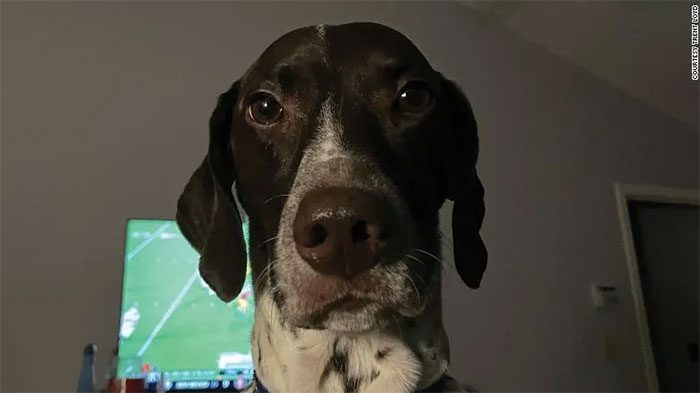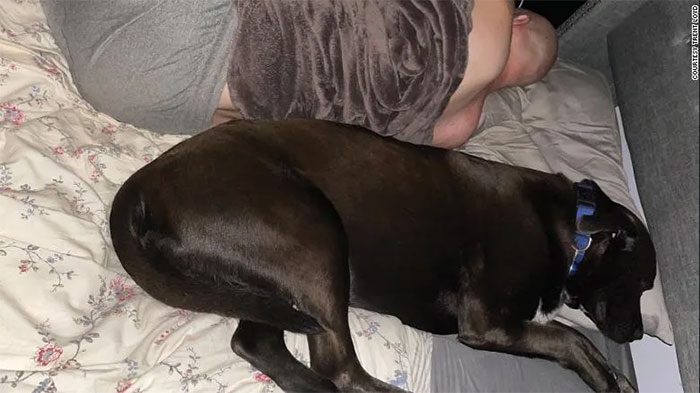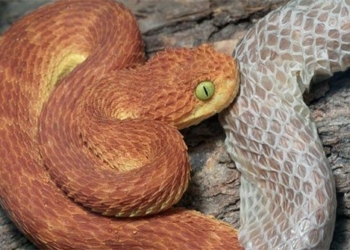One day, June, Wudan Yan’s German Shepherd, suddenly flopped down on the floor, dozing off. Then, its large, smooth paws began to twitch as if it were kicking at something in the air. June seemed to be chasing something in its dreams. According to Wudan Yan, it looked like June was following the scent of some invisible prey.
“Sometimes while sleeping, its feet move vigorously, as if it’s running on an invisible treadmill. It seems like it must be dreaming, perhaps chasing squirrels and rabbits,” Wudan Yan said.

“Does the boss still think there’s room for him on this bed?” – Delilad, a 10-year-old Siberian Husky.
Neuroscientist Marcos Frank, a professor at Washington State University who studies sleep in animals, believes that the behaviors Yan observed in his pet are completely common. “I’ve seen those actions in my own dogs. They run, whimper, bark, or even wake up not knowing where they are,” he said.
So what exactly does June dream about? The dream life of animals has intrigued human curiosity for thousands of years, yet we still haven’t found a definitive answer.
Unintentional muscle twitching is common in both dogs and humans. This occurs when a dog’s limbs and paws suddenly shake or move continuously while sleeping, most frequently during the REM sleep cycle. Additionally, eye twitching during sleep is also associated with this sleep phase.
In humans, the REM sleep stage is closely linked to vivid dreaming. It is a time filled with strange, colorful experiences that you would eagerly recount to your family upon waking.
According to a study published in 1977 in the journal Physiology & Behavior, dogs experience many REM sleep phases, accounting for about 12% of their total lifespan. Since other aspects of sleep in dogs are quite similar to human sleep, scientists believe these similarities may also manifest in dreams.
“From dogs to humans, most mammals exhibit basic sleep states. We cannot definitively conclude that dogs dream like humans do, but it is a hypothesis worth considering,” Frank said.

“Who says you can’t fit everyone on one bed?”
As movements during sleep become more complex, something more than ordinary muscle twitches may be occurring.
Frank noted: “The act of almost running while asleep is unusual. There is a mechanism in the brain that actively paralyzes the body from the neck down. It prevents you from acting out things that could be harmful while dreaming.”
This structure is called the pons, located in the brainstem. Damage to the pons can impair the ability to paralyze the body during sleep.
In the 1970s, scientists discovered that if the brainstem of domestic cats is damaged, it causes them to move more while sleeping. For example, the cats in the study raised their heads, moved their legs, and even jumped.
Pons damage due to neurological disorders can also affect the ability to paralyze the body during sleep. For humans, a significant increase in sleep startle symptoms can be an early warning sign of Parkinson’s disease. If you notice similar behavior in your dog, you should take it to the veterinarian.
For humans, REM sleep plays a role in memory consolidation, and there is some evidence that this also occurs in animals.
In a 2001 study published in the journal Neuron, researchers observed brain wave activity in sleeping mice and concluded that they replayed daily events during this time. When the mice ran through a circular maze before falling into deep sleep, they seemed to repeat the little knowledge they gained in the maze while asleep. In 2017, a study published in the journal Scientific Reports showed that dogs might use their naptime to reinforce memories formed while awake.
Marc Bekoff, a professor emeritus of ecology and evolutionary biology at the University of Colorado, stated that wild relatives of dogs also exhibit similar behaviors while sleeping.
The dogs involved in the study began learning to follow new commands. A week after the first training session, those that slept after training (instead of continuing to play) demonstrated better task performance than their counterparts in the control group.
“There’s no reason not to believe that dogs may recall some past experiences while sleeping,” said Marc Bekoff, professor emeritus of ecology and evolutionary biology at the University of Colorado Boulder.

“Come on, boss! Turn off the TV and go to sleep,” Ellie, a 6-year-old German Shorthaired Pointer.
This behavior also occurs in the distant relatives of dogs. Professor Bekoff has spent countless hours in the field, observing sleeping wolves and coyotes. He noted that they all exhibit similar behaviors to pet dogs at home.
However, even if domestic dogs, wolves, and coyotes can recall events while sleeping, the results are still somewhat different from human dreams. “We dream of different things, but for dogs, that is not within their capacity,” Frank, a professor at Washington State University, said.
Although dogs do not have the best vision in the world, they possess an extraordinary sense of smell. “I think there are some sensory ranges that align with intellectual content. I always wonder if the dreams of dogs are the worlds they have sniffed out?”
Philosopher David M. Peña-Guzmán, an associate professor at San Francisco State University, noted that pet owners today are particularly attentive to the sleep lives of their “companions,” but this interest actually dates back to ancient times.
Peña-Guzmán revealed: “There are mentions of animal dreams in the works of Aristotle and several other Greek philosophers.”
Humans still enjoy speculating about the dreams of animals close to them, such as dogs and horses, he said. Peña-Guzmán noted that spending a lot of time with a domesticated animal makes it easier to imagine them as creatures with rich inner lives. Species that do not attract human attention, such as frogs and insects, tend to be overlooked in ancient literature.

Mason, a 3-year-old Labrador mix, loves to lean against his owner but hates being covered with a blanket.
Why would a philosopher care about animal dreams? In his book, Peña-Guzmán argues that the ability to dream indicates a certain level of consciousness in an animal. And when we recognize an animal’s consciousness, we may come to appreciate that ability, believing they deserve to be treated with respect, he writes.
Peña-Guzmán has found such dreams in the animal kingdom. He describes an octopus sleeping with colors shifting like a kaleidoscope, which some scientists consider evidence of REM sleep. He has written about zebra finches whose brain activity while sleeping is similar to when they are singing. Additionally, Peña-Guzmán suggests that fish may also dream.
Peña-Guzmán acknowledges that not all animal scientists agree with his conclusions about dreams, but one thing is clear: We have much to learn about the dreams of animal species.
“In dreams, you truly see the power of the mind at work. It is a powerful reminder of how we have underestimated and misunderstood animals and their yet-to-be-explored levels of intellect,” Peña-Guzmán said.


















































